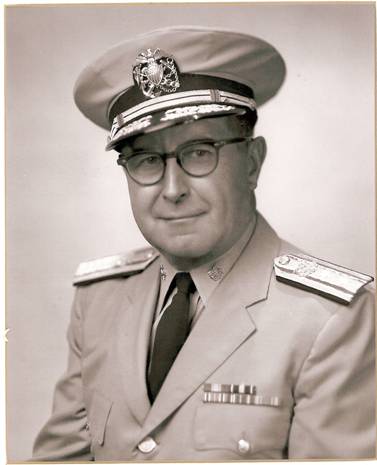

VERNON G. MacKENZIE, P.E.
Assistant Surgeon General
Rear Admiral, USPHS (ret.)
Vernon G. MacKenzie was born in Quincy, Massachusetts on July 19, 1906. His career included service as a city level engineer as well as a Federal Civil Service engineer, before beginning a distinguished decades-long career in the Public Health Service (PHS) Commissioned Corps. His career with the PHS included contributions to major segments of the Service including national defense sanitation facility construction during World War II, global health diplomacy in Greece, establishment of the forerunner of the Robert A. Taft Sanitary Engineering Center, and leadership at the headquarters office of the Service in Washington, DC. His strong leadership of the early Federal air pollution program is regarded as having been a critical foundation to its long term effectiveness.
Mackenzie received a Bachelor of Science degree in Engineering from the Massachusetts Institute of Technology in 1927 and took advanced course work at the Harvard University Graduate School of Business in 1951. He was a registered Professional Engineer in the State of Massachusetts.
In 1927 Vernon MacKenzie married Alice R. Rasmussen in Boston, Massachusetts. The Mackenzie’s had two sons, Robert and Donald.
After graduation from undergraduate school, MacKenzie worked for nine years as an assistant sanitary engineer for the Sanitary District of Chicago, Illinois followed by three years as an Assistant Sanitary Engineer in the Department of Public Works of the city of Detroit, Michigan. In 1939 he began his Federal service as a Civil Service engineer at the then PHS Water and Sanitation Investigation Station at Cincinnati, Ohio.
On July 24, 1941, just prior to the U.S. entry into World War II, MacKenzie was commissioned as an engineer officer in the United States Public Health Service (PHS) and assigned to the Federal Surplus Property Board where he worked on the design and construction of National Defense Sanitation Facilities. He remained in that post until 1947 when he was assigned to the American Mission of Aid to a war torn Greece as the Deputy Director of the Public Health Division of that health diplomacy undertaking.
In 1948 MacKenzie transferred back to the Water and Sanitation Investigation station in Cincinnati, Ohio; this time as program head. While in that post he was instrumental in the adoption of a broader concept of the Station’s role as exemplified by the change in its name to the Environmental Health Center. This was the first practical recognition of the need for coordinated research into the multiple facets of the environment. He completed his work at that post in 1954 leaving in place an organization which was to become the Robert A. Taft Sanitary Engineering Center.
From 1954 to 1960, MacKenzie served as Assistant Chief for Research and Development of the Division of Sanitary Engineering Services at the PHS headquarters in Washington, DC. In 1960 he began service as head of the PHS air pollution control program with his assignment as the Chief of the Division of Air Pollution in the Bureau of State Services, and later in the Bureau of Disease Prevention. In his work as head of PHS air pollution activities, which continued from 1960 to 1968, MacKenzie is credited as having established the foundations for a robust Federal air pollution control program which led to marked improvements in air quality which the nation enjoys today.
On January 10, 1964 in recognition of his leadership and future potential, Vernon G. MacKenzie was appointed as an Assistant Surgeon General with the equivalent rank of Rear Admiral (RADM) in the PHS Commissioned Corps.
In July of 1968 with the formation of the Consumer Protection and Environmental Health Service, amalgamating all consumer protection and environmental health activities of the PHS into one organization, RADM MacKenzie was named as its Deputy Administrator. He retired from the PHS in August of 1968.
RADM MacKenzie was awarded the PHS Distinguished Service Medal and received the Royal Order of the Phoenix from the government of Greece for his extraordinary contributions to that nation’s rehabilitation. He also was the recipient of the American Campaign Medal, World War II Victory Medal, National Defense Service Medal, and the European-African-Middle Eastern Campaign Medal. In 1969 he was presented the Beatty Mellon Stewardship Award for his work in national pollution abatement by the Air and Waste Management Association. He was widely recognized for his international health efforts which included his service as U.S. representative on the World Health Organization’s Expert Committee on Air Quality Criteria and Methods of Measurement. He was a fellow of the American Society of Civil Engineers and the American Public Health Association and a life member of the Commissioned Officers Association of the USPHS. He was also a member of the American Water Works Association, the Air Pollution Control Association, the American Academy of Sanitary Engineers and the Water Pollution Control Federation.
Upon his retirement from the PHS, MacKenzie and his family moved to Sanibel, Florida and later to Naples, Florida. In both locations he worked as an engineering consultant. He was also active in civic affairs in both Florida communities, including service as Vice Mayor of Sanibel where the City Council meeting room bears his name. He passed away in Naples, Florida on July 4, 1982.
July 2008
Back to History of USPHS Engineers